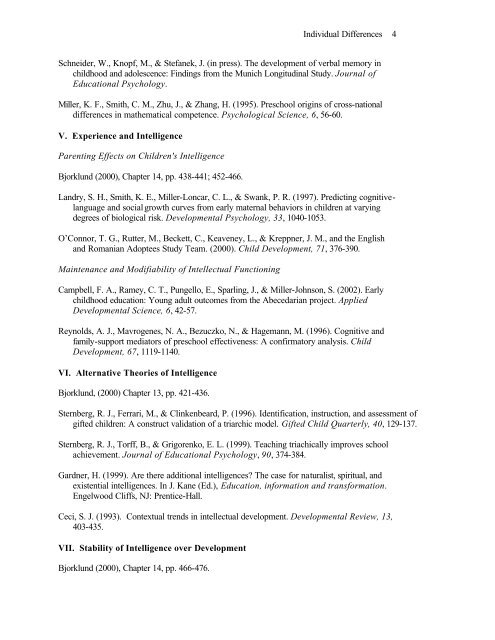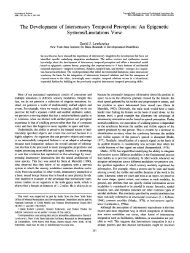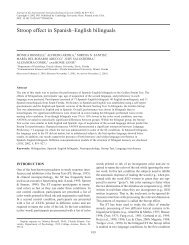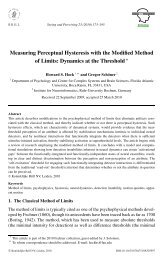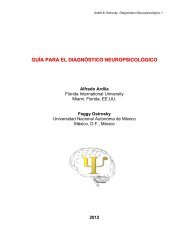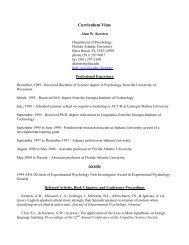Seminar in Individual Differences in Children's Thinking
Seminar in Individual Differences in Children's Thinking
Seminar in Individual Differences in Children's Thinking
You also want an ePaper? Increase the reach of your titles
YUMPU automatically turns print PDFs into web optimized ePapers that Google loves.
<strong>Individual</strong> <strong>Differences</strong> 4Schneider, W., Knopf, M., & Stefanek, J. (<strong>in</strong> press). The development of verbal memory <strong>in</strong>childhood and adolescence: F<strong>in</strong>d<strong>in</strong>gs from the Munich Longitud<strong>in</strong>al Study. Journal ofEducational Psychology.Miller, K. F., Smith, C. M., Zhu, J., & Zhang, H. (1995). Preschool orig<strong>in</strong>s of cross-nationaldifferences <strong>in</strong> mathematical competence. Psychological Science, 6, 56-60.V. Experience and IntelligenceParent<strong>in</strong>g Effects on <strong>Children's</strong> IntelligenceBjorklund (2000), Chapter 14, pp. 438-441; 452-466.Landry, S. H., Smith, K. E., Miller-Loncar, C. L., & Swank, P. R. (1997). Predict<strong>in</strong>g cognitivelanguageand social growth curves from early maternal behaviors <strong>in</strong> children at vary<strong>in</strong>gdegrees of biological risk. Developmental Psychology, 33, 1040-1053.O’Connor, T. G., Rutter, M., Beckett, C., Keaveney, L., & Kreppner, J. M., and the Englishand Romanian Adoptees Study Team. (2000). Child Development, 71, 376-390.Ma<strong>in</strong>tenance and Modifiability of Intellectual Function<strong>in</strong>gCampbell, F. A., Ramey, C. T., Pungello, E., Sparl<strong>in</strong>g, J., & Miller-Johnson, S. (2002). Earlychildhood education: Young adult outcomes from the Abecedarian project. AppliedDevelopmental Science, 6, 42-57.Reynolds, A. J., Mavrogenes, N. A., Bezuczko, N., & Hagemann, M. (1996). Cognitive andfamily-support mediators of preschool effectiveness: A confirmatory analysis. ChildDevelopment, 67, 1119-1140.VI. Alternative Theories of IntelligenceBjorklund, (2000) Chapter 13, pp. 421-436.Sternberg, R. J., Ferrari, M., & Cl<strong>in</strong>kenbeard, P. (1996). Identification, <strong>in</strong>struction, and assessment ofgifted children: A construct validation of a triarchic model. Gifted Child Quarterly, 40, 129-137.Sternberg, R. J., Torff, B., & Grigorenko, E. L. (1999). Teach<strong>in</strong>g triachically improves schoolachievement. Journal of Educational Psychology, 90, 374-384.Gardner, H. (1999). Are there additional <strong>in</strong>telligences? The case for naturalist, spiritual, andexistential <strong>in</strong>telligences. In J. Kane (Ed.), Education, <strong>in</strong>formation and transformation.Engelwood Cliffs, NJ: Prentice-Hall.Ceci, S. J. (1993). Contextual trends <strong>in</strong> <strong>in</strong>tellectual development. Developmental Review, 13,403-435.VII. Stability of Intelligence over DevelopmentBjorklund (2000), Chapter 14, pp. 466-476.


